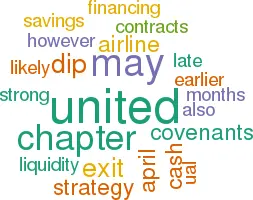Has United escaped Chapter 7 ?
June 2003


Only a couple of months ago United (by its own admission) was headed for Chapter 7 liquidation. However, the airline now believes that it could emerge from Chapter 11 bankruptcy much earlier than originally envisaged — possibly in late 2003 or early 2004. How realistic is such a scenario?
Despite continued heavy losses through April, UAL’s financial position has improved in recent months. The airline has reduced operating cash burn significantly and may even turn cash flow positive for the summer. It has met all of the monthly DIP loan covenants and maintained strong liquidity (it had $1.7bn of cash at the end of April).
In late April its unions ratified new contracts that will save the targeted $2.56bn annually over six years. At the end of May, the tally for annual lessor, lender and vendor concessions stood at almost $700m, well over the $500m target. The company has also identified numerous extra savings (outsourcing, airport lease renegotiation, etc) on top of the original $1bn targeted from non labour/ vendor sources.
As a result, the aggregate savings look likely to greatly exceed the earlier $4bn target and may even reach $5bn. This means a significant reduction in unit costs, possibly to the 8–cent range — a level that should make United a strong competitor.
United is expecting $400–500m savings in the current quarter from the labour deals that went into effect on May 1. After also receiving a $365m tax refund in April and $300m of federal aid in May (part of the security fee reimbursements), the airline probably has ample liquidity to meet the DIP covenants through the peak summer season.
The airline was also in the process of finalising its $1.8bn loan guarantee reapplication (the ATSB rejected the first bid in December but left the door open for it to be considered as a Chapter 11 exit financing option). Presentations to prospective private investors interested in providing exit financing were anticipated in early June.
United currently hopes to have a restructuring plan ready by September or October.
Starfish beached
The business plan is almost ready. There is likely to be one important change from the earlier tentative strategy: elimination of the unrealistic "Starfish" proposal in favour of "several revenue–boosting strategies". Nobody outside UAL had expected Starfish to materialise, so perhaps it was just a bargaining tool with the unions (it is not needed in light of the concessions granted by the pilots).
United has been surprisingly slow to sort out its regional strategy, given the important role that RJs play in its recovery efforts. By not affirming contracts, adjusting rates or making decisions about route allocation, it kept its United Express partners in limbo for six months.
However, by late May things were moving, with the signal that all contracts would have to be renegotiated.
United appears not to have made any significant progress in attracting private equity and debt investors to provide some or all of the exit financing. Before filing for Chapter 11 United had a lot of interest from buyout firms, including Texas Pacific Group (which had just lost its bid for US Airways), and such firms may still play a role in the exit strategy. Otherwise, there is believed to be interest in UAL from various quarters.
It is possible that UAL wants to get the Chapter 11 exit strategy sorted out well before the winter season, while it still enjoys strong liquidity.
It has so far tapped only the first $800m tranche of the $1.5bn DIP facility and may not need the remaining $700m. However, if the need arises later, getting access to those funds is not guaranteed, because the cash flow targets in the second- tranche DIP covenants are fairly onerous.
US airlines' prospects are currently heavily dependent on some degree of revenue recovery by year–end — if it does not take place, there are likely to be Chapter 11 filings. For United in its current state, a no–recovery scenario would probably mean early–autumn breaches of the DIP covenants and subsequent liquidation.